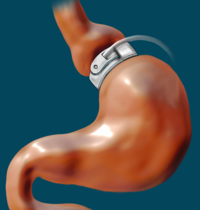
Photo from wikipedia
BACKGROUND Outpatient laparoscopic appendectomy is being used increasingly as a treatment option for acute, uncomplicated appendicitis. This was a prospective validation study in a large, urban, public safety-net hospital. STUDY… Click to show full abstract
BACKGROUND Outpatient laparoscopic appendectomy is being used increasingly as a treatment option for acute, uncomplicated appendicitis. This was a prospective validation study in a large, urban, public safety-net hospital. STUDY DESIGN From 2014 to 2016, all patients undergoing laparoscopic appendectomy for acute, uncomplicated appendicitis were enrolled in a prospective observational trial. Standard baseline perioperative practice (control group) was documented for 1 year. An outpatient appendectomy protocol was then introduced. Inclusion criteria required intraoperative confirmation of uncomplicated appendicitis and strict discharge criteria, including physician assessment before discharge. Data collection then continued for 1 year (outpatient group). The outcomes measures examined included complications, length of stay, nursing transitions, emergency department visits, readmissions, and patient satisfaction. RESULTS The study enrolled 351 patients (178 control, 173 outpatient). Of the 173 candidates for outpatient appendectomy, 113 went home. Reasons for admission included surgeon discretion due to intraoperative findings/medical comorbidities and lack of transportation home. The outpatient group had shorter operative time (69 vs 83 minutes; p < 0.001), longer time in recovery (242 vs 141 minutes; p < 0.001), fewer nursing transitions (4 vs 5; p < 0.001), and shorter postoperative length of stay (9 vs 19 hours; p < 0.001). There was no difference in complications, emergency department visits, or readmissions. In the outpatient group, none of the patients sent home from recovery had postoperative complications or required readmission. Satisfaction surveys revealed no change in satisfaction with either protocol. CONCLUSIONS Outpatient appendectomy is safe in a public hospital and results in shorter hospital length of stay and decreased healthcare costs. Strict criteria for discharge are important to identify patients who should be admitted for observation.
Journal Title: Journal of the American College of Surgeons
Year Published: 2017
Link to full text (if available)
Share on Social Media: Sign Up to like & get
recommendations!